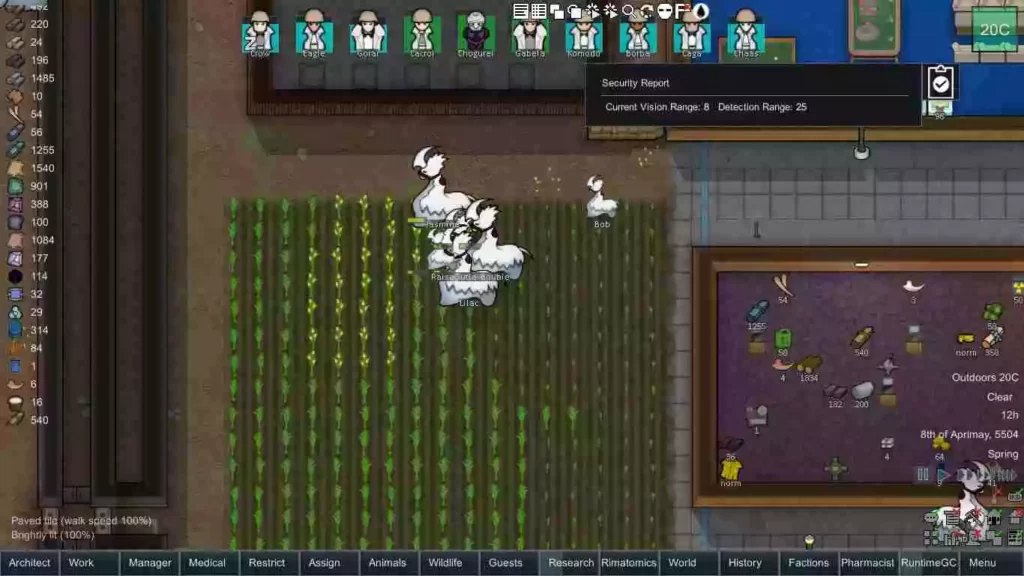Every food scrap matters in the harsh environment of RimWorld, where surviving is the only priority and supplies are limited. But what happens when the food choices of your colonists and those of your animals conflict? This guide delves into the challenging process of forbidding animals in the RimWorld realm from ingesting particular meals.
Players in the lauded colony management game RimWorld may grow and take care of a variety of animals. These animals perform a variety of tasks, including resource provision and cargo transportation. Nevertheless, controlling their feeds might be difficult, particularly if you want to protect priceless human dinners or make sure your animals don’t consume hazardous chemicals.
Here is our guide on How to restrict animals from eating certain foods.
How to restrict animals from eating certain foods?

In this comprehensive guide, we’ll go over a variety of ideas and methods that you may use to prevent your animals from eating things that could be hazardous to their health or that they could make better use of elsewhere.
In this section, we will dig into the mechanics of animal management, covering topics such as zoning, training, and properly managing nutritional constraints. By the time you’ve finished reading this essay, you’ll be well-prepared to keep a RimWorld colony functioning efficiently and peacefully while shielding your animal companions from the nutritional hazards that may befall them.
STEP 1: Acquiring Knowledge about the Diets of RimWorld Animals
It is crucial to understand how RimWorld manages animal diets and the possible problems connected with having unrestricted access to food items before we dig into the tactics for restricting particular meals.
Some of the creatures that live in RimWorld, such as cows and buffalos, are herbivores and must consume their food mostly in the form of plants or hay. Some animals, like wolves and wargs, are carnivores and must be fed raw flesh or goods derived from animals in order to survive.
It is possible to cause health problems, decreased productivity, and even death by allowing animals to ingest certain meals that are intended for human consumption or have harmful consequences, such as poisonous substances.
It is possible that the success or failure of your efforts to maximize resource utilization will depend on how well you manage the diets of your animals. You want your animals to consume what is healthiest for them while minimizing the amount of food that is wasted.
STEP 2: Animal Roaming Areas
Now that we understand how important it is to maintain control over the food that your animals consume in RimWorld, let’s discuss some of the most successful techniques for doing so:
Within RimWorld, you have the ability to assign certain territories to various creatures. You should designate some places for your animals where they are free to wander and graze, but you should make sure that these areas are not near any regions that contain prohibited foods.
In a similar fashion, establish stockpiling zones, particularly for animal food, which should be kept apart from stockpiles of food for humans.
STEP 3: Provide Training
You should give the task of training your animals to a colonist who has good handling skills. The orders “obedience” and “release” are included in this training, and they enable you to exert control over the actions and behaviors of your animals. To prevent your animals from straying into prohibited regions, further, educate them in specialized jobs such as hauling or rescue missions.
STEP 4: Putting Boundaries Around It
Blocking access to locations where human food is stored can be accomplished by the use of walls, doors, or even animal-only spaces. In order to prevent animals from gaining access to stored food and crops, fences or walls should be constructed around any outside spaces.
STEP 5: Micromanaging Different Kinds of Food
You may customize grazing zones for herbivorous animals by using the “Manage Areas” menu. This will ensure that the animals can only access the predetermined regions that contain safe plants or hay. In RimWorld, you have the ability to restrict certain types of food in animal feeding zones.
This helps to ensure that the animals only consume what is healthy for them and designed for them specifically.
STEP 6: Using Advanced Methods
Consider the following advanced strategies if you are an experienced RimWorld player who is interested in taking your animal management to the next level:
Construct hydroponics basins to enable the indoor cultivation of animal feed. This not only guarantees a consistent supply throughout the year but also shields crops from both the dangers posed by wild animals and the elements.
It is important to zone your food storage according to the sort of food being stored, whether it be raw meat, veggies, prepared meals, or anything else. By doing so, you will have complete command over the kinds of foods that may be given to your animals.
Make food that is tailored to the needs of your animals by utilizing nutritional paste dispensers. These machines are able to be programmed to make meals that are customized to meet the nutritional needs of your dogs.
Conclusion
In order to keep a flourishing and productive colony in RimWorld, one of the most important things you can do is manage the diets of your animals.
You may prevent your animals from eating dangerous items and maximize the use of your resources if you are familiar with the nutritional needs of your animals, adopt useful tactics to meet those needs, such as zoning, training, and access limitation, and then follow through with those plans.
It doesn’t matter if you’re dealing with herbivores, carnivores, or omnivores; the important thing is to find a way to strike a balance that preserves the health and well-being of your animal friends while also maximizing your colony’s chances of survival in the harsh climate of RimWorld.
Follow us on Twitter & like our Facebook page for more post-updates.

An experienced gaming content writer who emphasizes on offering the most recent information and how-to tutorials for the trending titles. Being a Hardcore gamer himself, he likes to try an array of games and likes to spend his time exploring them. He likes to unwind by listening to R&B music when he’s not writing about gaming stuff.

